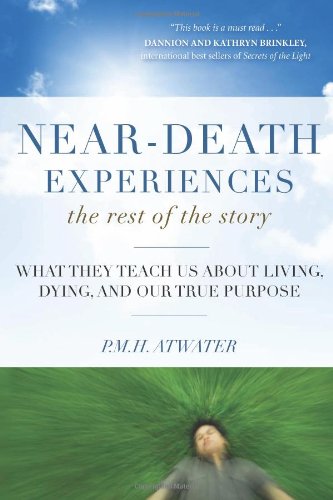Book review: Near Death Experiences: The Rest of the Story
by P.M.H. Atwater
★★★★
Before I begin this review, I should explain my interest in NDE’s from a religious viewpoint. It’s not just that they hint of a possible afterlife, because I honestly don’t know what to make of that. It’s that they dig down below the surface of religion to what Atwater labels a “core experience.” Says Atwater,
“The core truth or root of all religions and all sacred traditions is virtually the same throughout the world and always has been. It is the spiritual. It is that personal experience of Source/Deity/Allah/God. The majority of near-death experiencers glimpse that core truth in a moment of self-surrender they neither understood nor were prepared for, and they are forever changed.” (p. 104)
Atwater is not a scientist, and doesn’t approach her research from that direction. No double-blind studies with a control group. But she has logged 43 years of research, involving nearly 7,000 people. She explains,
“I am an observer and analyst who specializes in fieldwork … My protocol is that of a police investigator. I cross-check my findings with different people in different parts of our country at different times.” (p. 238)
By the way, I’m an outsider. An estimated one in twenty people remember a near-death experience, and Atwater has enjoyed three herself. But No NDE for me, even though I should qualify, having drowned once. I’m still peeved that I got nothing out of that.
Atwater’s new book is not as much about the experiences themselves as it is about the profound affect they have on those who survive them. People are changed by this brush with the divine, whether we label it a religious experience or not. I do enjoy when Atwater lets the experiencers speak for themselves, leaving it up to us to make sense of the mysteries. When she jumps in, speaking in her exotic language, using phrases like “electromagnetic spectrum,” I tend to lose focus. I’m a newbie to the paranormal, sorry.
This is a world where animals often speak and angels often fly on wings. I say “often,” because different people, with different backgrounds, have different experiences. Hell is only hot and fiery if you’re a Christian fundamentalist. Most others recalled hellish NDE’s as cold and clammy. Dark tunnels often connect this world to the next, but they didn’t used to. Tunnels with a light at the end were quite rare in NDE’s before Robert Moody’s book Life After Life became a bestseller, and the public began to fixate on tunnels. Too bad; everybody loves afterlife tunnels and the explanations they provide for wormholes, time travel, and shamanic visions.
But one commonality in these experiences is that they are life-altering, and for that reason alone, the rest of us should not ignore what we can’t explain. What these people experience will probably never be a part of our worldview—most of us are trapped in a reality wrapped around matter—but NDE experiencers’ connection often remains after the event, like a window left open to the supernatural. They are suddenly changed. Experiencers begin to remember the future before it happens, see auras of energy, see dead people. Atwater helps experiencers adapt back to a world that has become foreign, and helps the rest of us adapt to experiencers who have been radically changed. This is no trivial issue; 21% of experiencers in Atwater’s research attempted suicide afterward. 75% divorced. Both spouses usually voiced the same complaint: “I don’t know that person anymore.” The vast majority return from their experiences convinced that there is a “plan” for life, yet two-thirds leave organized religion, or never have a religious commitment to begin with.
Atwater loses me when she delves into her otherworldly explanations for these phenomenon, talking about holograms and power punches and colloidal conditions. When she shifts from paranormal language into scientific explanations, I get at least a glimpse of what she’s talking about, but can’t really relate the explanations to scientific principles other than as vague parallels meant to describe the indescribable. “Superfluidity” doesn’t really explain how out-of-body travelers can go through walls. “Quantum entanglement” has a long way to go before it explains entangled minds. “Multiverses” is a concept I find more than a little disturbing. But these comparisons do help me relate. In many ways, Atwater’s book will feel like home to experiencers but leave outsiders like me still out in the cold. Four stars for the research and fascinating peek into a world that remains a bizarre mystery to the uninitiated.
One final note: Atwater’s opinions about Jesus and the Bible don’t increase her credibility. She should probably have left that to the Jesus scholars. 












 354 Circles
354 Circles
 603 Goodreads Friends & Fans
603 Goodreads Friends & Fans

 Hello! I'm an author, historical Jesus scholar, book reviewer, and liberal Christian, which means I appreciate and attempt to exercise the humanitarian teachings of Jesus without getting hung up on any particular supernatural or religious beliefs.
The Bible is a magnificent book that has inspired and spiritually fed generations for thousands of years, and each new century seems to bring a deeper understanding of life’s purpose. This is true of not only Christianity; through the years, our age-old religions are slowly transforming from superstitious rituals into humanitarian philosophies. In short, we are growing up, and I am thrilled to be riding the wave.
I avidly read all thought-provoking religion titles. New authors: I'd love to read and review your book!
Hello! I'm an author, historical Jesus scholar, book reviewer, and liberal Christian, which means I appreciate and attempt to exercise the humanitarian teachings of Jesus without getting hung up on any particular supernatural or religious beliefs.
The Bible is a magnificent book that has inspired and spiritually fed generations for thousands of years, and each new century seems to bring a deeper understanding of life’s purpose. This is true of not only Christianity; through the years, our age-old religions are slowly transforming from superstitious rituals into humanitarian philosophies. In short, we are growing up, and I am thrilled to be riding the wave.
I avidly read all thought-provoking religion titles. New authors: I'd love to read and review your book!
 Hi! While Lee writes the articles and reviews the books, I edit, organize, and maintain the blog. The views expressed here are Lee's but I'm his biggest supporter! :-)
Hi! While Lee writes the articles and reviews the books, I edit, organize, and maintain the blog. The views expressed here are Lee's but I'm his biggest supporter! :-)
Connect With Me!